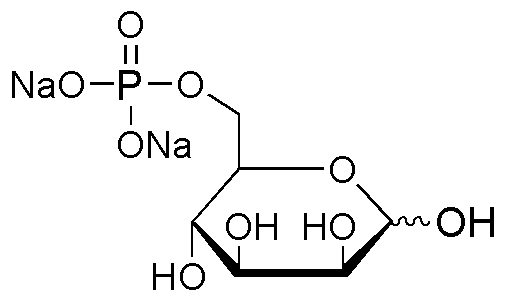D-Mannose 6-phosphate disodium salt is widely utilized in research focused on:
- Urinary Tract Infection (UTI) Prevention: This compound is known for its ability to inhibit the adhesion of bacteria to the urinary tract lining, making it a valuable supplement for individuals prone to recurrent UTIs.
- Metabolic Research: D-Mannose 6-phosphate plays a role in carbohydrate metabolism studies, helping researchers understand metabolic pathways and their implications in conditions like diabetes.
- Pharmaceutical Formulations: Its properties make it a suitable excipient in drug formulations, enhancing the stability and bioavailability of active pharmaceutical ingredients.
- Cell Culture Applications: This compound is used in cell culture media to support the growth of specific cell types, particularly in studies involving kidney and bladder cells.
- Biochemical Assays: D-Mannose 6-phosphate is utilized in various biochemical assays to measure enzyme activity and metabolic processes, providing insights into cellular functions.
General Information
Properties
Safety and Regulations
Applications
D-Mannose 6-phosphate disodium salt is widely utilized in research focused on:
- Urinary Tract Infection (UTI) Prevention: This compound is known for its ability to inhibit the adhesion of bacteria to the urinary tract lining, making it a valuable supplement for individuals prone to recurrent UTIs.
- Metabolic Research: D-Mannose 6-phosphate plays a role in carbohydrate metabolism studies, helping researchers understand metabolic pathways and their implications in conditions like diabetes.
- Pharmaceutical Formulations: Its properties make it a suitable excipient in drug formulations, enhancing the stability and bioavailability of active pharmaceutical ingredients.
- Cell Culture Applications: This compound is used in cell culture media to support the growth of specific cell types, particularly in studies involving kidney and bladder cells.
- Biochemical Assays: D-Mannose 6-phosphate is utilized in various biochemical assays to measure enzyme activity and metabolic processes, providing insights into cellular functions.
Documents
Safety Data Sheets (SDS)
The SDS provides comprehensive safety information on handling, storage, and disposal of the product.
Product Specification (PS)
The PS provides a comprehensive breakdown of the product’s properties, including chemical composition, physical state, purity, and storage requirements. It also details acceptable quality ranges and the product's intended applications.
Certificates of Analysis (COA)
Search for Certificates of Analysis (COA) by entering the products Lot Number. Lot and Batch Numbers can be found on a product’s label following the words ‘Lot’ or ‘Batch’.
Numéro de catalogue
Numéro de lot/série
Certificates Of Origin (COO)
This COO confirms the country where the product was manufactured, and also details the materials and components used in it and whether it is derived from natural, synthetic, or other specific sources. This certificate may be required for customs, trade, and regulatory compliance.
Numéro de catalogue
Numéro de lot/série
Safety Data Sheets (SDS)
The SDS provides comprehensive safety information on handling, storage, and disposal of the product.
DownloadProduct Specification (PS)
The PS provides a comprehensive breakdown of the product’s properties, including chemical composition, physical state, purity, and storage requirements. It also details acceptable quality ranges and the product's intended applications.
DownloadCertificates of Analysis (COA)
Search for Certificates of Analysis (COA) by entering the products Lot Number. Lot and Batch Numbers can be found on a product’s label following the words ‘Lot’ or ‘Batch’.
Numéro de catalogue
Numéro de lot/série
Certificates Of Origin (COO)
This COO confirms the country where the product was manufactured, and also details the materials and components used in it and whether it is derived from natural, synthetic, or other specific sources. This certificate may be required for customs, trade, and regulatory compliance.


